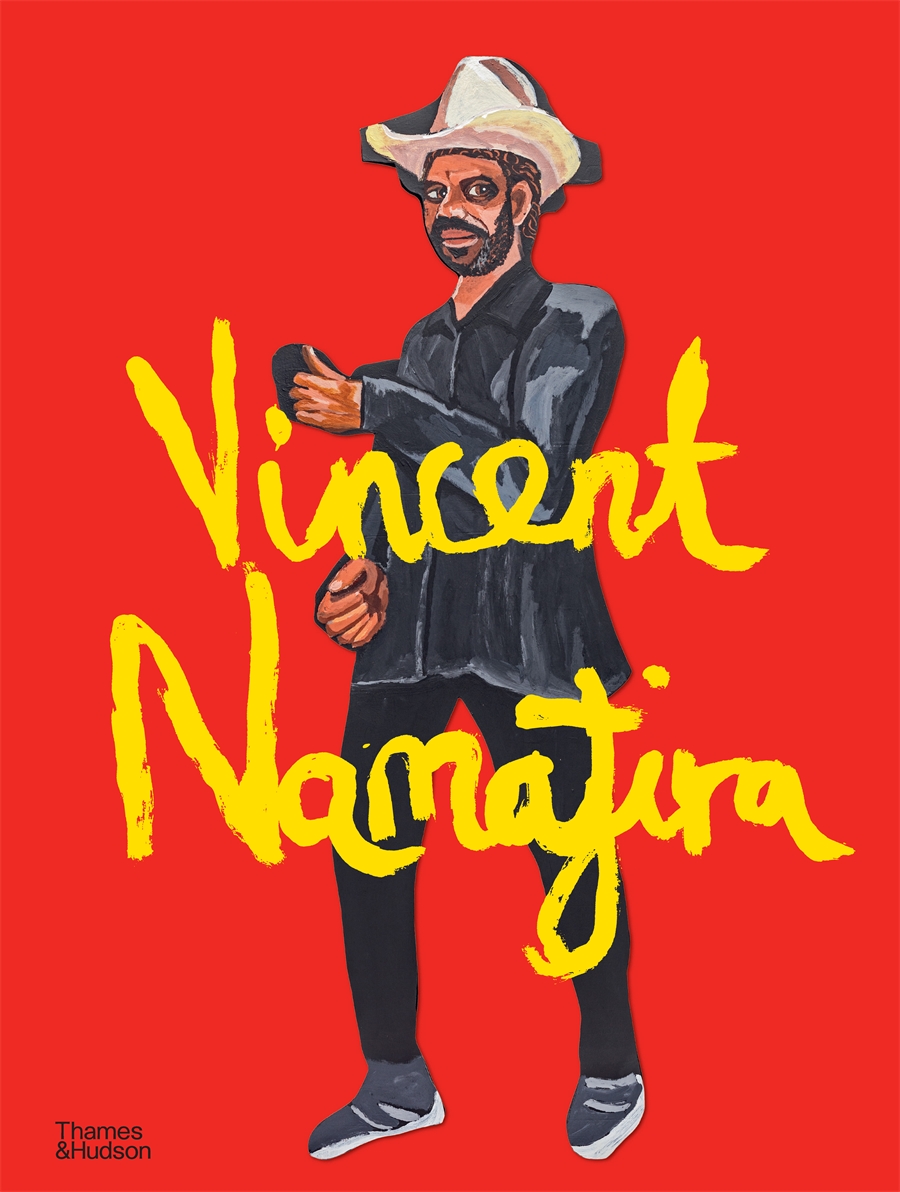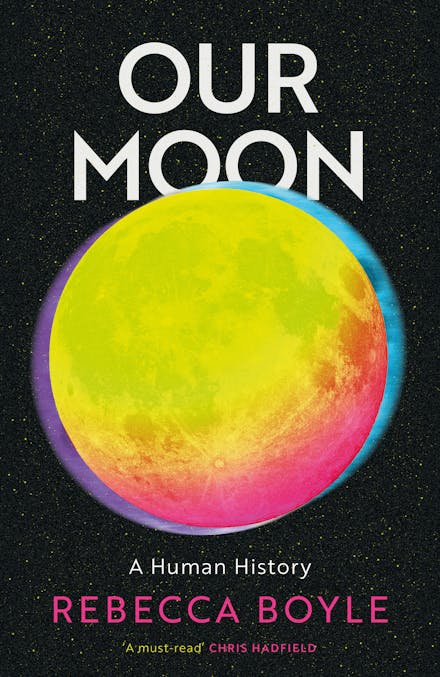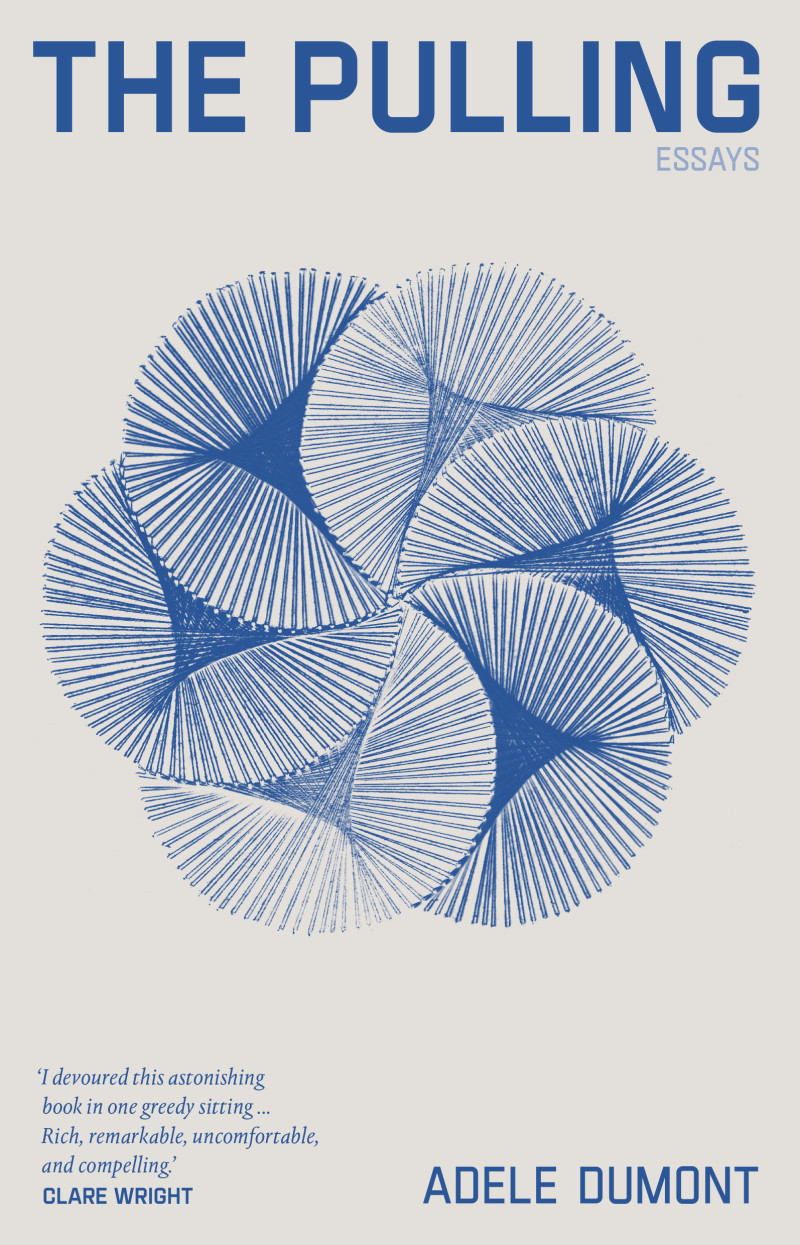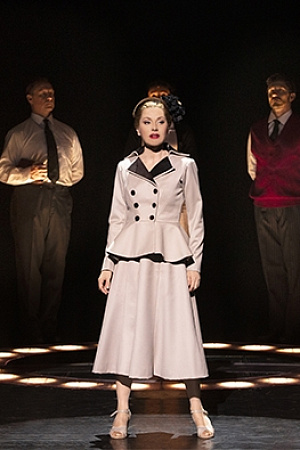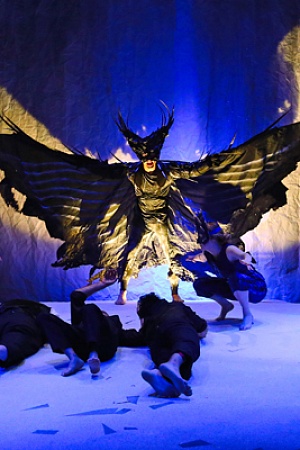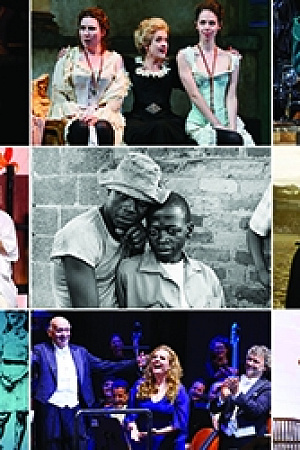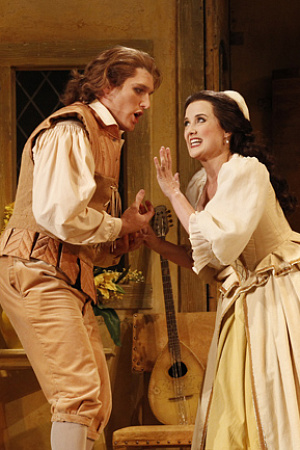Hamlet (Glyndebourne Opera Festival) ★★★★★
Three ‘new’ operatic versions of Hamlet in two years: the time is certainly not ‘out of joint’ for Shakespeare. Italian composer and conductor Franco Faccio’s Amleto was successfully premièred in Genoa in 1865, but then had a disastrous performance at La Scala in Milan in 1871. An indisposed tenor playing the murderously challenging title role effectively sabotaged the performance, which went ahead against the desires of the composer: a performance with a ‘voiceless Hamlet’, as the critics noted. A devastated Faccio destroyed most of his music, except the autograph score of the opera, and did not compose another note of music, but established a career as an outstanding conductor.
The opera then completely disappeared for well over a hundred years, until American scholar and conductor Anthony Barrese, whose interest in Verdi led him to Faccio, discovered the crumbling original manuscript score in the publishing firm Casa Ricordi’s archives in Milan. He created a performing edition, which was premièred in Albuquerque by Opera Southwest in 2014. However, the opera finally triumphantly resurfaced in its European homeland in Bregenz, Austria, in 2016.
Amleto is a vividly powerful work, with a composer in command of his musical and dramatic material; it draws on many middle and late nineteenth-century Italian operatic conventions, but also points forward to the verismo operas of the end of the century. It has an excellent libretto by Arrigo Boito, outstanding composer in his own right, and librettist of Verdi’s two late masterpieces, Otello and Falstaff. Verdi, Boito, and Faccio came together at the première of Otello – regarded by many as the greatest Shakespeare opera – with Faccio conducting. One can only wonder what might have happened to later Italian opera development but for a sick tenor.
Verdi famously stated that when adapting Shakespeare, ‘one must take the bull by the horns’. Boito’s observed drily that it was like ‘squeezing the juice out of a fruit’. Shakespeare continues to fascinate composers, and another Hamlet appeared during the Shakespeare anniversary year of 2016, in Vienna. Young German composer Anno Schreier, with Austrian playwright Thomas Jonigk, premièred their version at the Theater an der Wien. It is an intense and taut contemporary family drama. Shakespeare’s text provides a bare dramatic scaffolding performed by a chorus, while new words and reconfigured events inform the family relationships that unravel into tragedy.
A recurring verbal and musical motif – es gibt keinen Ausweg (there is no escape) – encapsulates the drama, expanding Shakespeare's metaphor of Denmark as a prison. These repetitions intensify the claustrophobic atmosphere of the opera. A macabre, often comic element is provided by the ghost of the murdered King Hamlet, a suave and dapper spoken role which acts as an ironic and acerbic commentary on the foibles of the living, and weaves through the action, unseen by the ‘real’ characters, sometimes contradicting and mocking their comments and actions.
English-language Shakespeare adaptions have always proven problematic and there are few in the repertory. Benjamin Britten’s A Midsummer Night’s Dream (1958) is frequently performed and highly regarded, while Thomas Adés’s The Tempest (2004) has enjoyed success and several new productions. Now a new English-language Shakespeare opera seems set to take its place in the operatic repertoire. Brett Dean is recognised as one of the foremost contemporary classical composers. His first opera, Bliss (2010), based on Peter Carey’s novel, enjoyed a level of success unprecedented for contemporary Australian opera, with performances in Sydney, Melbourne, and Edinburgh, and a second production in Hamburg, conducted by Simone Young, who had been instrumental in commissioning the work for Opera Australia.
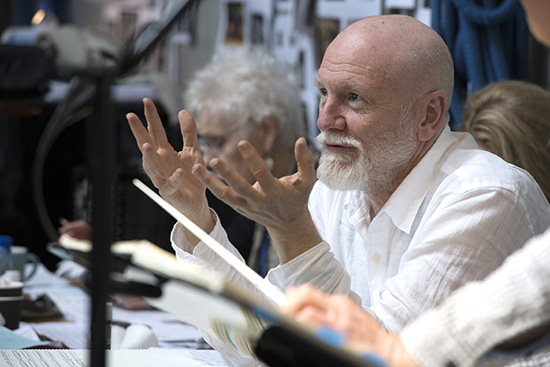 Brett Dean (photograph by Richard Hubert Smith)
Brett Dean (photograph by Richard Hubert Smith)
Commissioned by Glyndebourne Opera, Dean was hesitant about tackling such a monumental work – there are over forty operatic versions, few surviving – but soon decided, much in the way that Verdi and Boito approached Shakespeare, that one must needs be uninhibited and even ruthless in the use of the original material. Collaborating with Canadian director and librettist Matthew Jocelyn, they examined the three versions of the play that form the basis of the text – any performance of the play is necessarily an adaptation as there is no one canonical version – and used some of the First, or ‘bad’ Quarto, thought to be the imperfect recollections of an actor who played Marcellus in Shakespeare’s time; a version which provides a quirky yet poetic variation on the standard Second Quarto and First Folio versions. An early decision was to use only Shakespeare’s text, apart from a few small additions for the chorus. This is in stark contrast to Adés’s strategy in The Tempest, where the original text is filtered and refracted through a contemporary demotic. Jocelyn, however, frequently reassigns text from one character to another, or to different places in the unfolding events.
As was his practice with Bliss, Dean has composed a series of fragments from the opera as stand-alone concert works for performance prior to the première. His second string quartet, And once I played Ophelia, incorporated a soprano voice into the texture, while he wrote Gertrude Fragments for his mezzo daughter Lotte Betts-Dean, and Rooms of Elsinore for the combination of viol and piano. A final work that emerged directly from the opera-in-progress, From Melodious Lay (A Hamlet Diffraction), is a twenty-minute operatic scena for two voices, investigating the relationship between Hamlet and Ophelia and using similar orchestral forces as those in the opera.
Dean has made innovative use of the particular theatre spaces at Glyndebourne, including having part of the chorus sing from the orchestra pit and in the auditorium, while the orchestral forces are divided into different sections, with two groups playing in spaces under the theatre ceiling. The orchestral writing uses a range of different tunings for the instruments as well as calling for unusual playing techniques. There is also the incorporation of an accordionist, the virtuoso Scottish musician James Crabb, who is part of the group of players in the play-within-the-play. Dean also employs electronic elements, as was the practice in Bliss. From the rumbling and indeterminate brass opening of the opera to the plangent solo cello at the end – ‘Good-night sweet prince’ – Dean’s orchestral sound world is dazzling: his music is often darkly intense and beautiful, and it would be hard to name a contemporary opera composer his equal.
Shakespearean scholar Gary Schmidgall notes that ‘no sensible producer decides to cook up a Hamlet without first catching his prince’. As is the case with most operatic versions, the title role is taken by a tenor, in this case the versatile and expressive British singer Allan Clayton, who has established a strong reputation as one of the best young singers of his generation. The role is immense: he is on stage virtually the whole opera, and his is an impressively sustained physical as well as vocal performance. A bear-like, dishevelled, and shambling figure, he is lithe and athletic at the same time; a persona in stark contrast to the pale and gaunt Hamlet figures of popular imagination, but it works superbly. He is a disturbing presence from the start, while his mercurial changes of mood and emotion are captured in spiky, febrile music, which often dissolves into snatches of lyricism. His voice has beauty when necessary, but power and projection throughout, including a considerable amount of Sprechgesang.
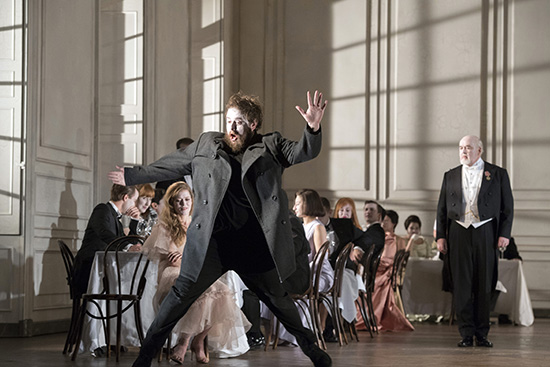 Allan Clayton and the cast of Hamlet at the Glyndebourne Opera Festival
Allan Clayton and the cast of Hamlet at the Glyndebourne Opera Festival
(photograph by Richard Hubert Smith)
Opposite him is Canadian soprano Barbara Hannigan, one of the most versatile and highly regarded singers in contemporary opera, also with a burgeoning conducting career. The role of Ophelia, in the various versions of the play, has little more than 150 lines; Hamlet has more than ten times this amount. However, all the operatic versions understandably expand this role to provide a strong vocal and dramatic foil to the prince. Hannigan has an almost balletic physical presence, and Dean demands equivalent vocal acrobatics from her, although not to the same extreme voice-breaking extent as Adés’s Ariel. Most operatic versions have Ophelia’s madness as a musical high point, and Dean does not disappoint. Drawing on operatic tradition which demands coloratura pyrotechnics, Hannigan triumphantly negotiates these challenges while performing extreme physical manoeuvres. She fully matches Clayton dramatically and musically.
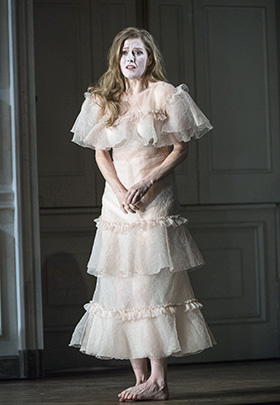 Barbara Hannigan in Hamlet at the Glyndebourne Opera Festival (photograph by Richard Hubert Smith)Gertrude and Claudius are the renowned singers Sarah Connolly and Rod Gilfry, performers vastly experienced in contemporary opera, and both provide powerful physical and vocal presences throughout the drama. Connolly’s despairing shuffle off the stage at the end of act one is heartbreaking, seemingly as mad as her son, while her soliloquy, ‘There is a willow ...’, on the death of Ophelia, but in duet with Ophelia’s distant voice, is poignant and beautifully sung. The great British bass John Tomlinson intones suitable sepulchral tones as the Ghost, and contributes wonderfully comic turns as the first player and gravedigger with a most impressive whistling obligato to Hamlet’s ‘Alas poor Yorick’. Kim Begley is an effectively pedantic yet moving Polonius. To misquote Macbeth, who would have thought that the play had so much comedy in it, but the brilliantly slapstick effect of the Tweedeldum and Tweedledee counter tenor double act of Rosencrantz (Rupert Enticknap) and Guildenstern (Christopher Lowrey) suggests a sequel: perhaps an operatic version of Tom Stoppard’s play?
Barbara Hannigan in Hamlet at the Glyndebourne Opera Festival (photograph by Richard Hubert Smith)Gertrude and Claudius are the renowned singers Sarah Connolly and Rod Gilfry, performers vastly experienced in contemporary opera, and both provide powerful physical and vocal presences throughout the drama. Connolly’s despairing shuffle off the stage at the end of act one is heartbreaking, seemingly as mad as her son, while her soliloquy, ‘There is a willow ...’, on the death of Ophelia, but in duet with Ophelia’s distant voice, is poignant and beautifully sung. The great British bass John Tomlinson intones suitable sepulchral tones as the Ghost, and contributes wonderfully comic turns as the first player and gravedigger with a most impressive whistling obligato to Hamlet’s ‘Alas poor Yorick’. Kim Begley is an effectively pedantic yet moving Polonius. To misquote Macbeth, who would have thought that the play had so much comedy in it, but the brilliantly slapstick effect of the Tweedeldum and Tweedledee counter tenor double act of Rosencrantz (Rupert Enticknap) and Guildenstern (Christopher Lowrey) suggests a sequel: perhaps an operatic version of Tom Stoppard’s play?
As is the case with all Glyndebourne operas, the smaller roles are uniformly strongly cast with a broad cross-section of rising and already established young talent. Laertes (David Butt Philip) and Horatio (Jacques Imbrailo) are both outstanding dramatically and vocally. Accordionist James Crabb might have an operatic career ahead of him. Dean’s decision to use this non-operatic instrument in the play-within-the-play scene is a masterstroke. It is such an unexpected sonority, and Crabb’s virtuosic playing underpins the broad comedy as each player quotes their own favourite line from the play, culminating in Tomlinson’s cavernous ‘To be, or not to be ...’, which then results in a dispute about the correct wording – a little Shakespearean in-joke regarding the First Quarto, followed by a snatch of Latin plainchant. It all brought the house down.
Vladimir Jurowski, currently chief conductor of the London Philharmonic, returns to the pit after having recently relinquished his post as Glyndebourne music director. He directs the wide array of musical forces with a firm yet supple hand and expertly creates Dean’s kaleidoscopic sound world with memorable playing of this complex and challenging score from the London Philharmonic. The layout and virtuosity of the orchestral forces adds sometimes eerie and estranging effects, seemingly without an identifiable source. The chorus is outstanding, providing a vocal soundtrack that weaves virtually throughout the opera and a spine-chilling wall of sound when necessary, as well as being a commanding and vivid physical presence.
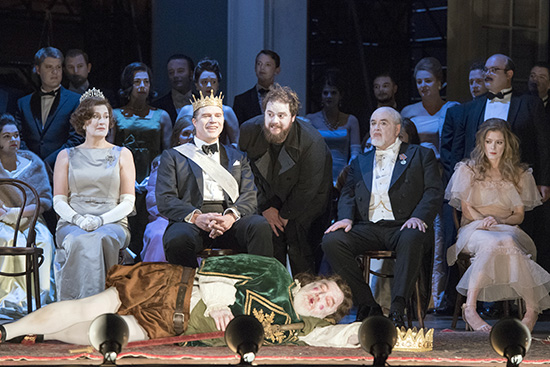 The cast of Hamlet at the Glyndebourne Opera Festival
The cast of Hamlet at the Glyndebourne Opera Festival
(photograph by Richard Hubert Smith)
There is an all-Australian team overseeing the production. Neil Armfield directs – as he did with Bliss – while the set is by Ralph Myers, costumes by Alice Babidge, and lighting by Jon Clark. Armfield’s production is fluid and physical; the final extended duel scene is visceral and confronting, but the character direction is nuanced and subtle and the relationships clear and effective. Myers’s settings exploit the stage fully, suggesting the cavernous halls of Elsinore, and provide flexibility in playing spaces, supplemented by Clark’s subtle lighting. Babidge’s costumes range from ‘period’ to contemporary, strongly adding to the visual characterisation of the production.
As with all new operas, it is almost impossible to say at this stage whether Brett Dean’s Hamlet will have ‘legs’. The rapturous reception from an informed and sophisticated audience at the première suggests that it might. Let’s hope that before too long that will be an Australian reaction as well. Hamlet is an important and significant addition to contemporary opera.
Hamlet continues at the Glyndebourne Opera Festival until 6 July, 2017. Performance attended: 11 June 2017.
ABR Arts is generously supported by The Ian Potter Foundation.

